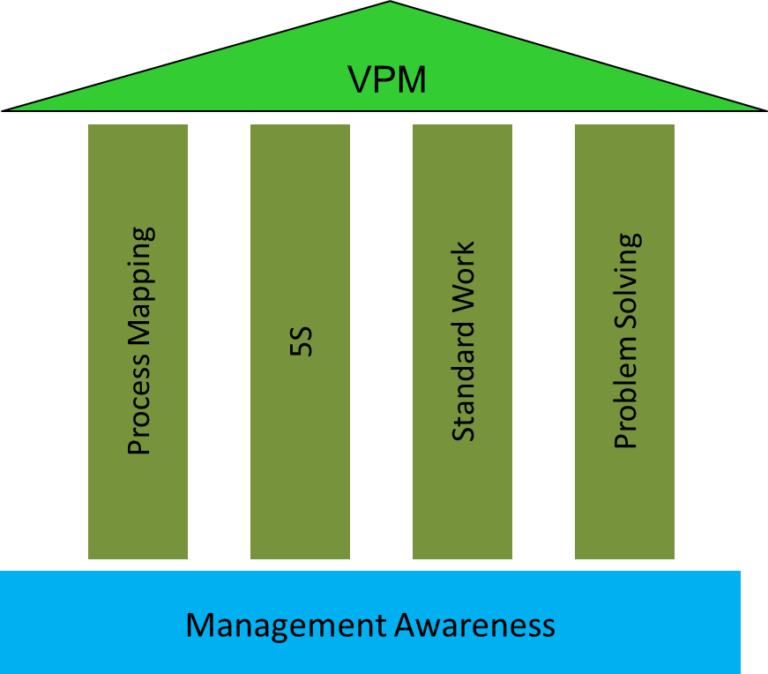Definition of Lean Office
The term Lean Office commonly refers to utilizing improvement methods used in manufacturing to improve administrative processes. These tools also apply to service industries, health care and public sector.
Application of Lean Office is based on a principle that any administrative or service process contains vast amounts of waste that can be eliminated through simple common sense problem solving methods and teamwork.
Methods such as 5S, Kaizen or Process Mapping as well as advanced problem solving techniques such as Six Sigma have been used with success in an office environment. Especially Six Sigma applies neatly in service industry because it forces thinking in terms of a process rather than departments or individual tasks.
Lean Office Temple
Management Awareness – working on changing behavior that will lead to the change in thinking, such as: an employee adding value is “the most important” to the company, safety is the highest priority, quality of service is more important than incurred costs.
Process Mapping – using a VSM tool to improve process flow.
5S – maintaining clean, visual and ergonomic work place.
Standard Work – implementation of standards for all repetitive tasks, training in their use (TWI), monitoring compliance and improving the way of working.
Problem Solving – using analytical tools: Pareto, Ishikawa, 5Why, etc. to solve common problems.
Visual Performance Management – managing daily work performance using visual metrics.
Implementing Lean Office
Improving performance in a service organization follows general implementation of Lean Management. The greatest emphasis will typically be placed on streamlining flow of processes. Conducting VSM achieves up to 80% of all benefits.
Process Mapping (Value Stream Mapping in Admin)
Administrative Value Stream Mapping shows process flow between workers and departments and showcases wastes in an organization. A well done map will also provide information about quantity of documents, processing times and will allow to calculate Lead Time and amount of work required to complete a unit of service.
Typical improvements expected after creating a current state map range from 20 to 30% reduction of time required to complete a process. Teams achieve this by reducing time, combining or eliminating tasks. A more radical “reingineering” approach allows to design a brand new process that has a much higher content of value added work.

VSM Workshop
The goal of the workshop is to map current state of a selected process and develop a plan for an improved state. Participants identify individual process steps, their duration and efficiency. During brainstorming the team eliminates, shortens or combines steps and plans changes that will improve the process. An action plan to implement improvements is developed, calculated results, measured percentage of improvements and a presentation of results before the company’s management are created.
Day 1
- Introduce Lean Management in administrative environment.
- Train in VSM methodology.
- Develop Current State Map for the onsite process.
- Calculate process efficiency, establish improvement goals.
- Train in methodology of process improvement.
- Present case studies from various organizations.
Day 2
- Brainstorm improvements – create Future State Map.
- Develop action plan to implement changes.
- Calculate expected gains.
- Present results to management.
Lean Office Simulation
The workshop describes implementation of Lean Management in administrative environment. Participants play a simulation game that illustrates transformation of administrative value streams. During two rounds, associates transform a quotation issuing process using Lean tools. They create a process map and brainstorm implementing TAKT Time, FIFO, one piece flow, etc.
The second day describes case studies from implementing 5S, Visual Management, Standardized Work and A3 problem solving methodology. Typical steps for introducing Lean into an organization are also presented.
Day 1
- Challenges for Lean Management in an administrative environment.
- Types of waste in administration, elimination of non value added activities.
- Identification of processes and value stream mapping.
- Techniques for process improvement.
Day 2
- Visual Office – implementing 5S and visual management
- Standard Work in administration
- A3 Problem Solving
- Managing a change process, effective leadership
- Steps for Lean implementation


